Heterogeneity of the Triassic Lacustrine Yanchang Shale in the Ordos Basin, China, and Its Implications for Hydrocarbon Primary Migration
Abstract
1. Introduction
2. Geological Background
3. Materials and Methods
3.1. Observation of Sand-Silt Intervals
3.2. Thin-Section Microscopy
3.3. Scanning Electron Microscopy (SEM)
3.4. X-Ray Diffraction Analysis
3.5. TOC and Rock-Eval Pyrolysis
3.6. Porosity Measurement
4. Results
4.1. Petrology and Geochemistry
4.2. Characteristics of Organic Matter (OM)
4.3. Pore System and Pore Size
4.3.1. Inorganic Pores
4.3.2. Organic Pores
4.3.3. Fractures
4.4. Porosity
5. Discussion
5.1. The Role of Sand-Silt Intervals in Primary Migration
5.2. The Primary Pathways for Hydrocarbon Migration
5.3. Petroleum Primary Migration Model
5.4. Implications for Shale Oil Exploration
6. Conclusions
- (1)
- The Yanchang shale exhibits heterogeneity in petrology, mineral composition, geochemistry, OM type, and OM content. Compared to organic-rich mudstones, sand-silt intervals typically have coarser grain sizes, higher quartz and feldspar content, higher OSI and RMSB values, and lower clay mineral content, as well as TOC, S1, and S2 values.
- (2)
- There are differences in dominant pore type, pore morphology, pore size, and porosity between mudstones and sand-silt intervals. Compared with mudstones, sand-silt intervals develop more inorganic pores with larger pore sizes, which are often filled with hydrocarbons and MSB with organic pores. The median pore size of inorganic and organic pores in sand-silt intervals is approximately 110 nm and 87 nm, respectively, with porosity ranging from 0.83% to 8.37%, averaging 4.32%. In contrast, the median pore size of inorganic and organic pores in mudstones is 40 nm and 65 nm, respectively, with porosity varying between 0.54% and 7.7%, averaging 3.24%.
- (3)
- In the Yanchang Formation, high-angle fractures, low-angle fractures, and fractures parallel to bedding are well-developed. High-angle fractures mainly trend in the east–west direction, with the north–south direction being secondary, and their dip angles are generally greater than 75 degrees. These fractures are commonly filled with calcite, solid bitumen, and liquid hydrocarbons.
- (4)
- Sand-silt intervals in the Yanchang shale serve as both “pathways” and “micro reservoirs” within source rock and play an important role in hydrocarbon storage and migration. Fractures with different trends and dips penetrate and connect the inorganic and organic pore networks, organic matter networks, and sand-silt intervals within different parts of the source rock to form pathways for the hydrocarbon primary migration within Yanchang shale. A speculative model for the primary migration of hydrocarbons in the Yanchang shale is proposed.
- (5)
- The sand-silt intervals in the Yanchang shale, characterized by higher brittleness and porosity, enhanced pore connectivity, higher OSI values, and improved oil quality, serve as sweet spots for shale oil and gas exploration.
Author Contributions
Funding
Institutional Review Board Statement
Informed Consent Statement
Data Availability Statement
Acknowledgments
Conflicts of Interest
Abbreviations
| FE-SEM | Field-emission scanning electron microscopy |
| MSB | Migrated solid bitumen |
| OSI | Oil saturation index |
| TOC | total organic carbon |
| S1 | free liquid hydrocarbons |
| S2 | total residual hydrocarbons |
| HI | Hydrogen index |
| Ro | Vitrinite reflectance |
| OM | Organic matter |
| UV | Ultraviolet |
| EDS | Energy-dispersive spectroscopy |
| POM | Primary solid organic matter |
| EOM | Extractable organic matter |
| OPs | Organic pores |
| interP | Inter-particle |
| intraP | Intra-particle |
| Q | Quartz |
| F | Feldspar |
| S | Siderite |
| Py | Pyrite |
References
- Tissot, B.P.; Welte, D.H. Petroleum Formation and Occurrence, 2nd ed.; Springer: Berlin, Germany, 1984; pp. 325–340. [Google Scholar]
- Inan, S.M.; Yalcin, M.N.; Mann, U. Expulsion of oil from petroleum source rocks: Inferences from pyrolysis of samples of unconventional grain size. Org. Geochem. 1998, 29, 45–61. [Google Scholar] [CrossRef]
- Kelemen, S.R.; Walters, C.C.; Ertas, D.; Freund, H.; Curry, D.J. Petroleum Expulsion Part 3. A Model of Chemically Driven Fractionation during Expulsion of Petroleum from Kerogen. Energy Fuel. 2006, 20, 309–319. [Google Scholar] [CrossRef]
- Zou, C.S.; Pan, B.Q.; Horsfield, B.; Yang, Z.; Hao, S.Y.; Liu, E.T.; Zhang, L.F. Oil retention and intrasource migration in the organic-rich lacustrine Chang 7 shale of the Upper Triassic Yanchang Formation, Ordos Basin, central China. AAPG Bull. 2019, 103, 2627–2663. [Google Scholar] [CrossRef]
- Hu, S.Z.; Li, S.F.; Xia, L.W.; Lv, Q.; Cao, J. On the internal oil migration in shale systems and implications for shale oil accumulation: A combined petrological and geochemical investigation in the Eocene Nanxiang Basin, China. J. Pet. Sci. Eng. 2020, 184, 106493. [Google Scholar] [CrossRef]
- Guo, Q.L.; Yao, Y.; Hou, L.H.; Tang, S.H.; Pan, S.Q.; Yang, F. Oil migration, retention, and differential accumulation in “sandwiched” lacustrine shale oil systems from the Chang 7 member of the Upper Triassic Yanchang Formation, Ordos Basin, China. Int. J. Coal Geol. 2022, 261, 104077. [Google Scholar] [CrossRef]
- Ji, W.M.; Hao, F.; Gong, F.; Gong, F.H.; Zhang, J.; Bai, Y.F.; Liang, C.; Tian, J.Q. Petroleum migration and accumulation in a shale oil system of the Upper Cretaceous Qingshankou Formation in the Songliao Basin, northeastern China. AAPG Bull. 2024, 108, 38. [Google Scholar] [CrossRef]
- Jin, Z.J.; Wang, G.P.; Liu, G.X.; Gao, B.; Liu, Q.Y.; Wang, H.L.; Liang, X.P.; Wang, R.Y. Research progress and key scientific issues of continental shale oil in China. Acta Petrol. Sin. 2021, 42, 821–835. [Google Scholar] [CrossRef]
- McAuliffe, C.D. Oil and gas migration—Physical and chemical constraints. AAPG Bull. 1979, 63, 61–781. [Google Scholar] [CrossRef]
- Leythaeuser, D.; Radke, M.; Schaefer, R.G. Efficiency of petroleum expulsion from shale source rocks. Nature 1984, 311, 745–748. [Google Scholar] [CrossRef]
- Stainforth, J.G.; Reinders, J.E.A. Primary migration of hydrocarbons by diffusion through organic matter networks, and its effect on oil and gas generation. Org. Geochem. 1990, 16, 61–74. [Google Scholar] [CrossRef]
- Leythaeuser, D.; Radke, M.; Willsch, H. Geochemical effects of primary migration of petroleum in Kimmeridge source rocks from Brae field area, North Sea. II: Molecular composition of alkylated naphthalenes, phenanthrenes, benzo and dibenzothiophenes. Geochim. Cosmochim. Acta 1988, 52, 2879–2891. [Google Scholar] [CrossRef]
- Pepper, A.S. Estimating the petroleum expulsion behaviour of source rocks: A novel quantitative approach. In Petroleum Migration; England, W.A., Fleet, A.J., Eds.; Special Publications; Geological Society: London, UK, 1991; Volume 59, pp. 9–31. [Google Scholar] [CrossRef]
- Luo, X.R.; Vasseur, G. Modelling of pore pressure evolution associated with sedimentation and uplift in sedimentary basins. Basin Res. 1995, 7, 35–52. [Google Scholar] [CrossRef]
- Kuo, L.C.; Hardy, H.H.; Owili-Eger, A.S.C. Quantitative modeling of organic matter connectivity in source rocks using fractal geostatistical analysis. Org. Geochem. 1995, 23, 29–42. [Google Scholar] [CrossRef]
- Mann, U.; Hantschel, T.; Schaeler, R.U.; Krooss, B.; Leythaeuser, D.; Littke, R.; Sachsenhofer, R.F. Petroleum mechanisms, pathways, efficiencies and numerical simulations. In Petroleum and Basin Evolution; Welte, D.H., Horslield, B., Baker, D.R., Eds.; Springer: Berlin, Germany, 1997; pp. 403–520. [Google Scholar] [CrossRef]
- Jin, Z.H.; Johnson, S.E. Primary oil migration through buoyancy-driven multiple fracture propagation: Oil velocity and flux. Geophys. Res. Lett. 2008, 35, 250–258. [Google Scholar] [CrossRef]
- Stainforth, J.G. Practical kinetic modeling of petroleum generation and expulsion. Mar. Pet. Geol. 2009, 26, 552–572. [Google Scholar] [CrossRef]
- Eseme, E.; Krooss, B.M.; Littke, R. Evolution of petrophysical properties of oil shales during high-temperature compaction tests: Implications for petroleum expulsion. Mar. Pet. Geol. 2012, 31, 110–124. [Google Scholar] [CrossRef]
- Curtis, M.E.; Sondergeld, C.H.; Ambrose, R.J.; Rai, C.S. Microstructural investigation of gas shales in two and three dimensions using nanometer-scale resolution imaging. AAPG Bull. 2012, 96, 665–677. [Google Scholar] [CrossRef]
- Loucks, R.G.; Reed, R.M. Scanning-electron-microscope petrographic evidence for distinguishing organic-matter pores associated with depositional organic matter versus migrated organic matter in mudrocks. GCAGS J. 2014, 3, 51–60. [Google Scholar]
- Löhr, S.C.; Baruch, E.T.; Hall, P.A.; Kennedy, M.J. Is organic pore development in gas shales influenced by the primary porosity and structure of thermally immature organic matter? Org. Geochem. 2015, 87, 119–132. [Google Scholar] [CrossRef]
- Cardott, B.J.; Landis, C.R.; Curtis, M.E. Post-oil solid bitumen network in the Woodford Shale, USA—A potential primary migration pathway. Int. J. Coal Geol. 2015, 139, 106–113. [Google Scholar] [CrossRef]
- Raji, M.; Gröcke, D.R.; Greenwell, H.C.; Gluyas, J.G.; Cornford, C. The effect of interbedding on shale reservoir properties. Mar. Pet. Geol. 2015, 67, 154–169. [Google Scholar] [CrossRef]
- Lei, Y.H.; Luo, X.R.; Wang, X.Z.; Zhang, L.K.; Jiang, C.F.; Yang, W.; Yu, Y.X.; Cheng, M. Characteristics of silty laminae in Zhangjiatan Shale of southeastern Ordos Basin, China: Implications for shale gas formation. AAPG Bull. 2015, 99, 661–687. [Google Scholar] [CrossRef]
- Liang, C.; Cao, Y.C.; Liu, K.Y.; Jiang, Z.X.; Wu, J.; Hao, F. Diagenetic variation at the lamina scale in lacustrine organic-rich shales: Implications for hydrocarbon migration and accumulation. Geochim. Cosmochim. Acta 2018, 229, 112–128. [Google Scholar] [CrossRef]
- Maria, M.; Agnieszka, D.; Stankiewicz, A.B. Origin, properties, and implications of solid bitumen in source-rock reservoirs: A review. Int. J. Coal Geol. 2018, 195, 14–36. [Google Scholar] [CrossRef]
- Milliken, K.L.; Zhang, T.W.; Chen, J.P.; Ni, Y.Y. Mineral diagenetic control of expulsion efficiency in organic-rich mudrocks, Bakken Formation (Devonian- Mississippian), Williston Basin, North Dakota, U.S.A. Mar. Pet. Geol. 2021, 127, 104869. [Google Scholar] [CrossRef]
- Lei, Y.Y.; Luo, X.R.; Wang, X.Z.; Cheng, M. Effects of extractable organic matter from mature lacustrine shale on the pore structure and their implications. AAPG Bull. 2022, 106, 1239–1264. [Google Scholar] [CrossRef]
- Zhang, T.; Krooss, B.M. Experimental investigation on the carbon isotope fractionation of methane during gas migration by diffusion through sedimentary rocks at elevated temperature and pressure. Geochim. Cosmochim. Acta 2001, 65, 2723–2742. [Google Scholar] [CrossRef]
- Eseme, E.; Littke, R.; Krooss, B.M.; Schwaubauer, J. Experimental investigation of the compositional variation of petroleum during primary migration. Org. Geochem. 2007, 38, 1373–1397. [Google Scholar] [CrossRef]
- Han, Y.J.; Horsfield, B.; Wirth, R.; Mahlstedt, N.; Bernard, S. Oil retention and porosity evolution in organic-rich shales. AAPG Bull. 2017, 101, 807–827. [Google Scholar] [CrossRef]
- Han, Y.J.; Mahlstedt, N.; Horsfield, B. The Barnett Shale: Compositional fractionation associated with intraformational petroleum migration, retention, and expulsion. AAPG Bull. 2015, 99, 2173–2202. [Google Scholar] [CrossRef]
- Hawthorne, S.B.; Miller, D.J.; Kukowsk, K.; Grabanski, C.B.; Abarghani, A.; Azzolina, N.; Pekot, L.J.; Kurz, B.A.; Sorensen, J.A. Turtles and snakes—Evidence for molecular shape-selective migration of crude oil hydrocarbons in the Bakken petroleum system. Energy Fuel 2021, 35, 10584–10596. [Google Scholar] [CrossRef]
- Abarghani, A.; Ardakani, O.H.; Hawthorne, S.B.; Smith, S.A.; Kurz, B.A.; Sorensen, J.A. Application of aromatic/aliphatic ratios analysis in revealing migration pathways in unconventional reservoirs: A case study of the Bakken Shale. Int. J. Coal Geol. 2022, 260, 104070. [Google Scholar] [CrossRef]
- Ko, L.T.; Loucks, R.G.; Milliken, K.L. Controls on pore types and pore-size distribution in the Upper Triassic Yanchang Formation, Ordos Basin, China: Implications for pore-evolution models of lacustrine mudrocks. Interpretation 2017, 5, SF127–SF147. [Google Scholar] [CrossRef]
- Zhao, W.Z.; Hu, S.Y.; Hou, L.H.; Yang, T.; Li, X.; Guo, B.C.; Yang, Z. Types and resource potential of continental shale oil in China and its boundary with tight oil. Pet. Explor. Dev. 2020, 47, 1–10. [Google Scholar] [CrossRef]
- Ma, Y.S.; Cai, X.Y.; Zhao, P.R.; Hu, Z.Q.; Liu, H.M.; Gao, B.; Wang, W.Q.; Li, Z.M.; Zhang, Z.L. Geological Characteristics and Exploration Practice of Continental Shale Oil in China. Acta Geol. Sin. 2022, 96, 155–171. [Google Scholar] [CrossRef]
- Zou, C.N.; Ma, F.; Pan, S.Q.; Zhang, S.X.; Wu, S.T.; Fu, G.Y.; Wang, H.J.; Yang, Z. Formation and distribution potential of global shale oil and the developments of continental shale oil theory and technology in China. Earth Sci. Front. 2023, 30, 128–142. [Google Scholar] [CrossRef]
- Parnell, J.; Chen, H.H.; Middleton, D.; Haggan, T.; Carey, P. Significance of fibrous mineral veins in hydrocarbon migration: Fluid inclusion studies. J. Geochem. Explor. 2000, 69–70, 623–627. [Google Scholar] [CrossRef]
- Lash, G.G.; Engelder, T. An analysis of horizontal microcracking during catagenesis: An example from the Catskill delta complex. AAPG Bull. 2005, 89, 1433–1449. [Google Scholar] [CrossRef]
- Zhang, J.; Pang, X.Q.; Jiang, Z.X.; Chen, D.X.; Du, C.G. Primary Hydrocarbon Migration Paths and Evidence in Lower Es3 Source Rock, Niuzhuang-Liuhu Sag, Dongying Depression, China. Acta Geol. Sin. 2007, 81, 210–218. [Google Scholar]
- Gale, J.F.; Stephen, E.L.; Laubach, S.E.; Olson, J.E.; Eichhubl, P.; Fall, A. Natural fractures in shale: A review and new observations. AAPG Bull. 2014, 98, 2165–2216. [Google Scholar] [CrossRef]
- Shi, H.; Luo, X.R.; Xu, H.; Wang, X.Z.; Zhang, L.X.; Wang, Q.C.; Lei, Y.H.; Jiang, C.F.; Cheng, M.; Ma, S. Identification and distribution of fractures in the Zhangjiatan shale of the Mesozoic Yanchang Formation in Ordos Basin. Interpretation 2017, 5, SF167–SF176. [Google Scholar] [CrossRef]
- Teixeira, M.G.; Donzé, F.; Renard, F. Microfracturing during primary migration in shales. Tectonophysics 2017, 694, 268–279. [Google Scholar] [CrossRef]
- Berg, R.R.; Gangi, A.F. Primary migration by oil-generation microfracturing in low-permeability source rocks: Application to the Austin Chalk, Texas. AAPG Bull. 1999, 83, 727–756. [Google Scholar] [CrossRef]
- Ma, X.X.; Li, M.W.; Pang, X.Q.; Wei, X.Y.; Qian, M.H.; Tao, G.L.; Liu, P.; Jiang, Q.G.; Li, Z.M.; Zhao, Y.; et al. Paradox in bulk and molecular geochemical data and implications for hydrocarbon migration in the inter-salt lacustrine shale oil reservoir, Qianjiang Formation, Jianghan Basin, Central China. Int. J. Coal Geol. 2019, 209, 72–88. [Google Scholar] [CrossRef]
- Liang, C.; Cao, Y.C.; Jiang, Z.X.; Wu, J.; Song, G.Q.; Wang, Y.S. Shale oil potential of lacustrine black shale in the Eocene Dongying depression: Implications for geochemistry and reservoir characteristics. AAPG Bull. 2017, 101, 1835–1858. [Google Scholar] [CrossRef]
- Ping, H.W.; Li, C.Q.; Chen, H.H.; George, S.C.; Gong, S. Overpressure release: Fluid inclusion evidence for a new mechanism for the formation of heavy oil. Geology 2020, 48, 803–807. [Google Scholar] [CrossRef]
- Fan, Z.Q.; Jin, Z.H.; Johnson, S.E. Modelling petroleum migration through microcrack propagation in transversely isotropic source rocks. Geophys. J. Int. 2012, 190, 179–187. [Google Scholar] [CrossRef]
- Panahi, H.; Kobchenko, M.; Renard, F.; Mazzini, A.; Scheibert, J.; Dysthe, D.; Jamtveit, B.; Malthe-Sorenssen, A.; Meakin, P. A 4D synchrotron X-ray tomography study of the formation of hydrocarbon migration pathways in heated organic-rich shale. SPE J. 2014, 18, 366–377. [Google Scholar] [CrossRef]
- Oen, P.M.; Engel-Jensen, M.; Barendregt, A.A. Skjold Field, Danish North Sea: Early evaluations of oil recovery through water imbibition in a fractured reservoir. SPE Reserv. Eng. 1988, 3, 17–22. [Google Scholar] [CrossRef]
- O’Brien, N.R.; Slatt, M.R.; Senftlet, J. The significance of oil shale fabric in primary hydrocarbon migration. Fuel 1994, 73, 1518–1522. [Google Scholar] [CrossRef]
- Rokosh, D.; Pawlowicz, S.; Anderson, S.; Berhane, M.; Beaton, A. Shale fabric, mineralogy and effective porosity of the Upper Colorado Group. In Proceedings of the CSPG CSEG CWLS Convention, Calgary, AB, Canada, 4–8 May 2009; pp. 572–576. [Google Scholar]
- Aplin, A.C.; Macquaker, J.H.S. Mudstone diversity: Origin and implications for source, seal, and reservoir properties in petroleum systems. AAPG Bull. 2011, 95, 2031–2059. [Google Scholar] [CrossRef]
- Cheng, M.; Lei, Y.H.; Zhang, L.K.; Wang, X.Z.; Zhang, L.X.; Jiang, C.F.; Yin, J.T. Pore Type, pore Structure, and controlling factors in the Late Triassic Lacustrine Yanchang Shale, Ordos Basin, China. Energies 2021, 14, 3053. [Google Scholar] [CrossRef]
- Tao, H.; Jiang, F.J.; Pang, X.Q.; Liu, Y.; Wu, G.Y.; Zhou, K.; Xiao, H.Y.; Jiang, Z.X.; Li, M.W.; Jiang, S.; et al. Identification and evaluation of shale oil micromigration and its petroleum geological significance. Pet. Explor. Dev. 2024, 51, 127–140. [Google Scholar] [CrossRef]
- Yang, H.; Zhang, W.Z. Leading effect of the Seventh Member high-quality source rock of Yanchang Formation in Ordos Basin during the enrichment of low-penetrating oil-gas accumulation. Geochimica 2005, 34, 147–154. [Google Scholar] [CrossRef]
- Yang, J.J. Structural Evolution and Oil and Gas Distribution of Ordos Basin; Petroleum Industry Press: Beijing, China, 2002; pp. 20–45. [Google Scholar]
- He, Z.X. Evolution and Petroleum of Ordos Basin; Petroleum Industry Press: Beijing, China, 2003; pp. 20–50. [Google Scholar]
- Kong, Q.F. The organic maceral characteristic of Yanchang source rock in Ordos Basin. Xinjiang Petrol. Geol. 2007, 28, 163–166. [Google Scholar]
- Guo, H.J.; He, R.; Jia, W.L.; Peng, P.A.; Lei, Y.H.; Luo, X.R.; Wang, X.Z.; Zhang, L.X.; Jiang, C.F. Pore characteristics of lacustrine shale within the oil window in the Upper Triassic Yanchang Formation, southeastern Ordos Basin, China. Mar. Pet. Geol. 2018, 91, 279–296. [Google Scholar] [CrossRef]
- Guo, H.J.; Jia, W.L.; Peng, P.A.; Lei, Y.H.; Luo, X.R.; Cheng, M. The composition and its impact on the methane sorption of lacustrine shales from the Upper Triassic Yanchang For-mation, Ordos Basin, China. Mar. Pet. Geol. 2014, 57, 509–520. [Google Scholar] [CrossRef]
- Jiang, F.J.; Chen, D.; Wang, Z.F.; Xu, Z.Y.; Chen, J.; Liu, L.; Huyan, Y.Y.; Liu, Y. Pore characteristic analysis of a lacustrine shale: A case study in the Ordos Basin, NW China. Mar. Pet. Geol. 2016, 73, 554–571. [Google Scholar] [CrossRef]
- Yu, Y.X.; Luo, X.R.; Cheng, M. Study on the distribution of extractable organic matter in pores of lacustrine shale: An example of Zhangjiatan Shale from the Upper Triassic Yanchang Formation, Ordos Basin, China. Interpretation 2017, 5, SF109–SF126. [Google Scholar] [CrossRef]
- Bennett, R.H.; Hulbert, M.H.; Curry, K.J.; Curry, A.; Douglas, J. Organic matter sequestered in potential energy fields predicted by 3-D clay microstructure model: Direct observations of organo-clay micro-and nanofabric. Mar. Geol. 2012, 315, 108–114. [Google Scholar] [CrossRef]
- Milliken, K.L.; Rudnicki, M.; Awwiller, D.N.; Zhang, T.W. Organic matter–hosted pore system, Marcellus formation (Devonian), Pennsylvania. AAPG Bull. 2013, 97, 177–200. [Google Scholar] [CrossRef]
- Jacob, H. Classification, structure, genesis and practical importance of natural solid oil bitumen (“migrabitumen”). Int. J. Coal Geol. 1989, 11, 65–79. [Google Scholar] [CrossRef]
- Vandenbroucke, M.; Largeau, C. Kerogen origin, evolution and structure. Org. Geochem. 2007, 38, 719–833. [Google Scholar] [CrossRef]
- Desbois, G.; Urai, J.L.; Kukla, P.A. Morphology of the pore space in claystones—Evidence from BIB/FIB ion beam sectioning and cryo-SEM observations. EEarth 2009, 4, 15–22. [Google Scholar] [CrossRef]
- Loucks, R.G.; Reed, R.M.; Ruppel, S.C.; Jarvie, D.M. Morphology, genesis, and distribution of nanometer-scale pores in siliceous mudstones of the Mississippian Barnett shale. J. Sed. Res. 2009, 79, 848–861. [Google Scholar] [CrossRef]
- Slatt, R.M.; O’Brien, N.R. Pore types in the Barnett and Woodford gas shales: Contribution to understanding gas storage and migration pathways in fine-grained rocks. AAPG Bull. 2011, 95, 2017–2030. [Google Scholar] [CrossRef]
- Chalmers, G.R.; Bustin, R.M.; Power, I.M. Characterization of gas shale pore systems by porosimetry, pycnometry, surface area, and field emission scanning electron microscopy/transmission electron microscopy image analyses: Examples from the Barnett, Woodford, Haynesville, Marcellus, and Doig units. AAPG Bull. 2012, 96, 1099–1119. [Google Scholar] [CrossRef]
- Loucks, R.G.; Reed, R.M.; Ruppel, S.C.; Hammes, U. Spectrum of pore types and networks in mudrocks and a descriptive classification for matrix-related mudrock pores. AAPG Bull. 2012, 96, 1071–1098. [Google Scholar] [CrossRef]
- Ko, L.T.; Loucks, R.G.; Zhang, T.W.; Ruppel, S.C.; Shao, D.Y. Pore and pore network evolution of Upper Cretaceous Boquillas (Eagle Ford-equivalent) mudstone: Results from gold tube pyrolysis experiments. AAPG Bull. 2016, 100, 1693–1722. [Google Scholar] [CrossRef]
- Lucy, T.; Ko, L.T.; Loucks, R.G.; Ruppel, S.C.; Zhang, T.W.; Peng, S. Origin and characterization of Eagle Ford pore networks in the south Texas Upper Cretaceous shelf. AAPG Bull. 2017, 101, 387–418. [Google Scholar] [CrossRef]
- Jarvie, D.M. Shale resource systems for oil and gas: Part 2—Shale-oil resource systems. In Shale Reservoirs—Giant Resources for 21st Century; Beyer, J.A., Ed.; AAPG Memoir; American Association of Petroleum Geologists: Tulsa, OK, USA, 2012; Volume 97, pp. 89–119. [Google Scholar] [CrossRef]
- Sajgo, C.; Maxwell, J.R.; Mackenzie, A.S. Evaluation of fractionation effects during the early stages of primary migration. Org. Geochem. 1983, 5, 65–73. [Google Scholar] [CrossRef]
- Wei, L.; Mastalerz, M.; Schimmelmann, A.; Chen, Y. Influence of Soxhlet extractable bitumen and oil on porosity in thermally maturing organic-rich shales. Int. J. Coal Geol. 2014, 132, 38–50. [Google Scholar] [CrossRef]
- Price, L.C.; Clayton, J.L. Extraction of whole versus ground source rocks: Fundamental petroleum geochemical implications including oil-source rock correlation. Geochim. Cosmochim. Acta 1992, 56, 1213–1222. [Google Scholar] [CrossRef]
- Curiale, J.A. Origin of solid bitumens, with emphasis on biological marker results. Org. Geochem. 1986, 10, 559–580. [Google Scholar] [CrossRef]
- Zhang, T.W.; Fu, Q.L.; Sun, X.; Hackley, P.C.; Ko, L.T.; Shao, D.Y. Meter-scale lithofacies cycle and controls on variations in oil saturation, Wolfcamp A, Delaware and Midland Basins. AAPG Bull. 2021, 105, 1821–1846. [Google Scholar] [CrossRef]
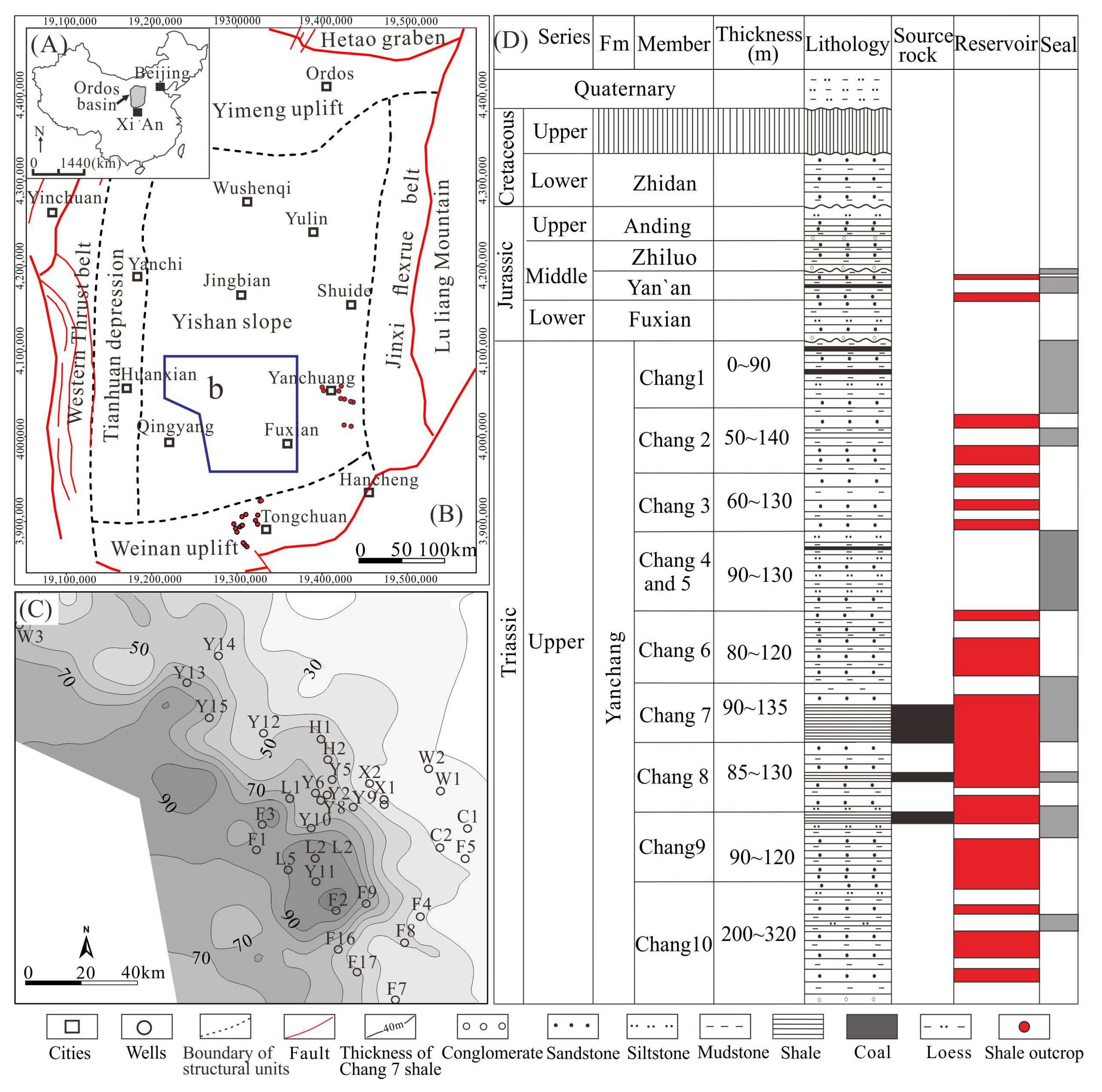





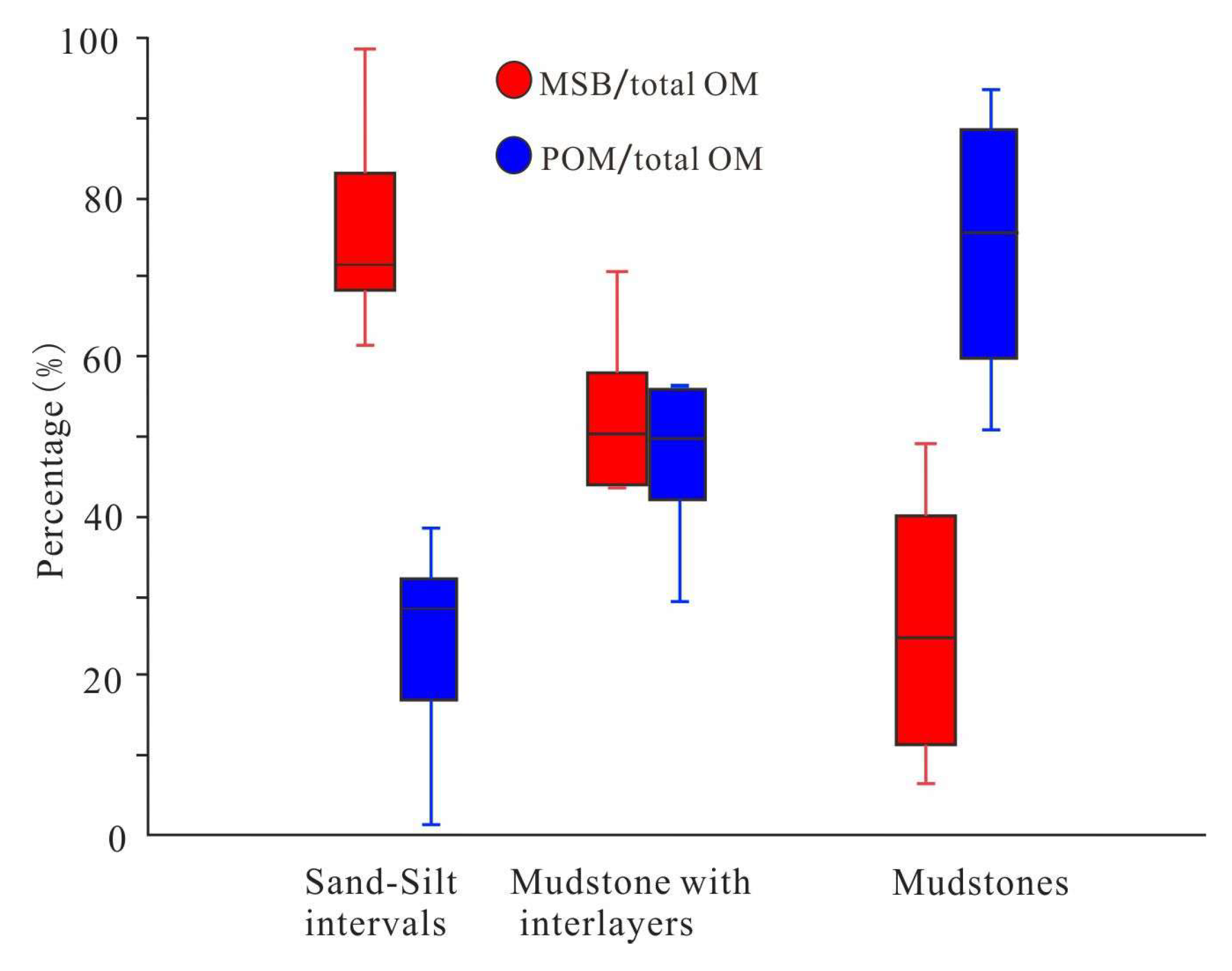



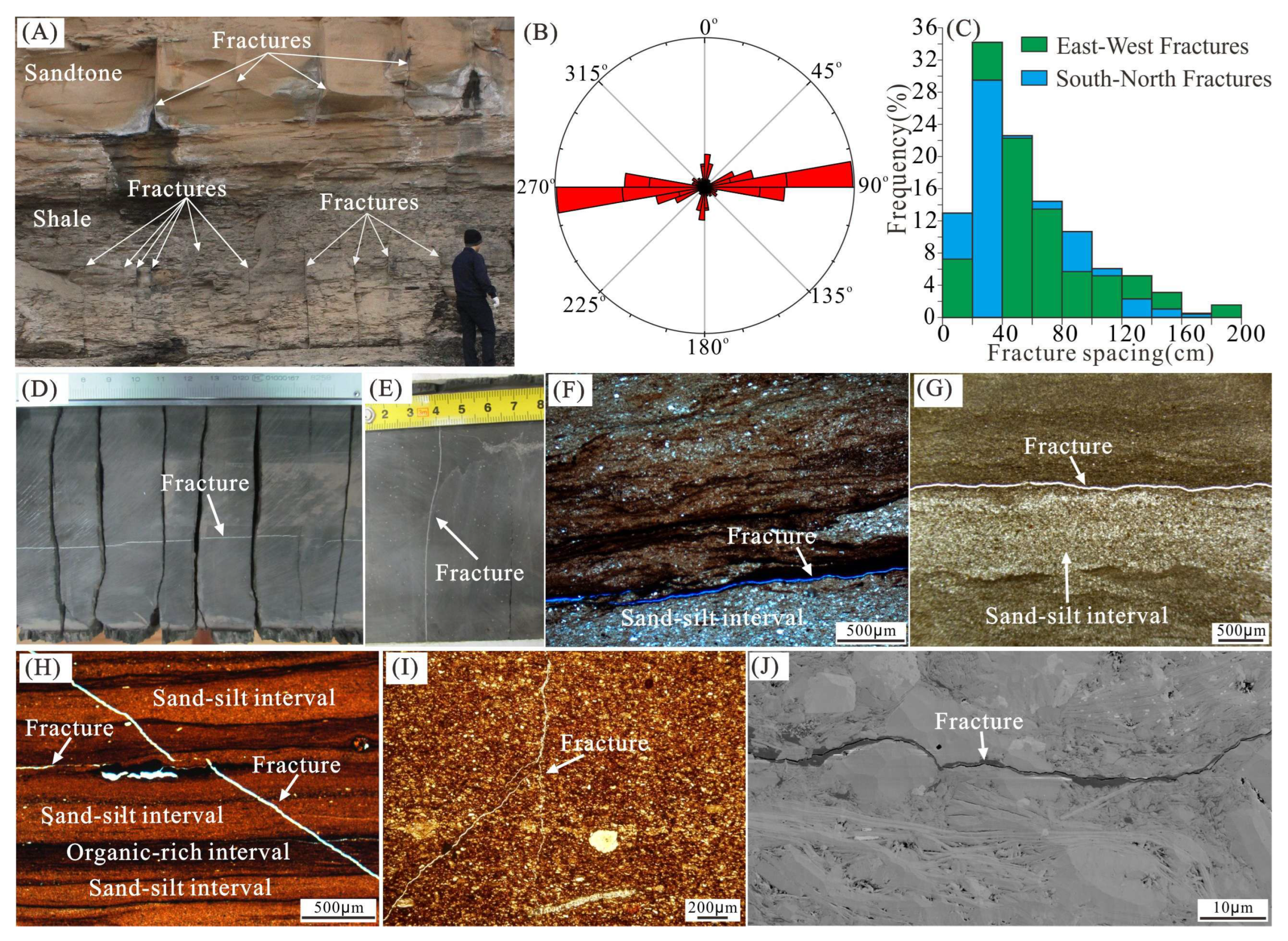
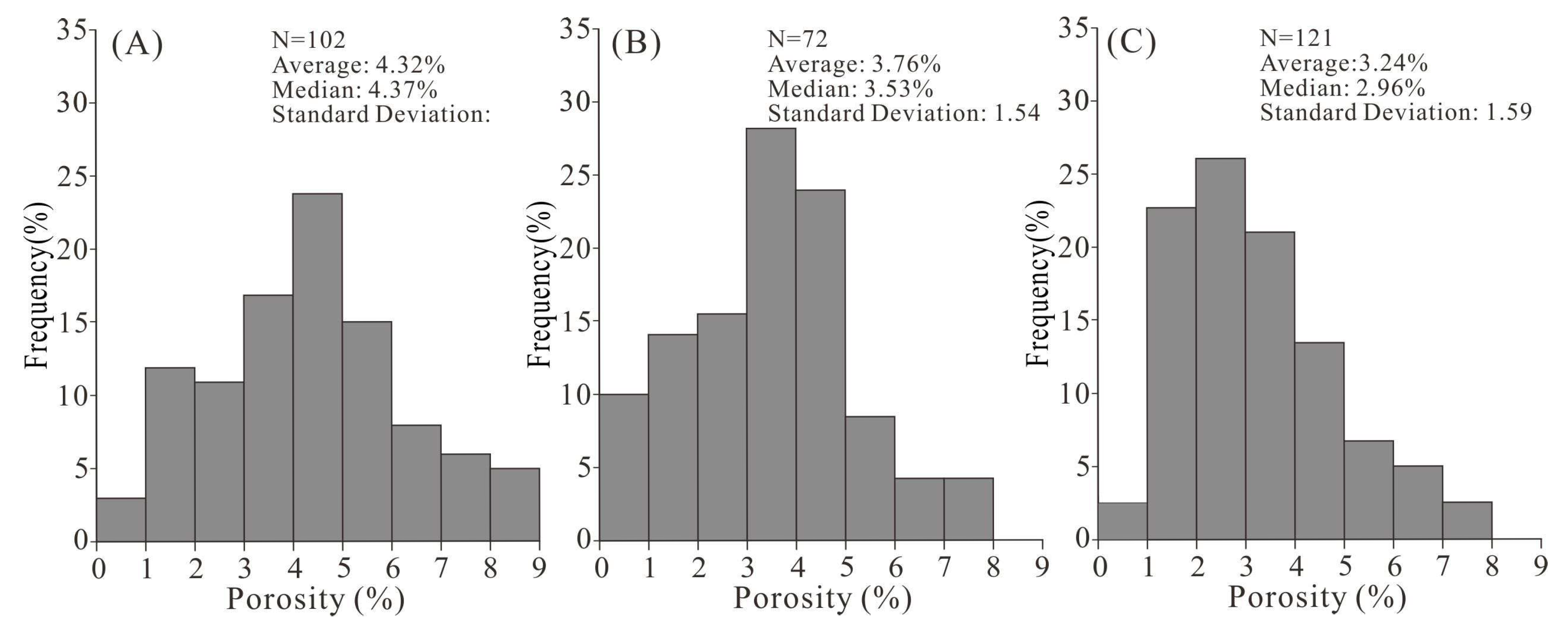
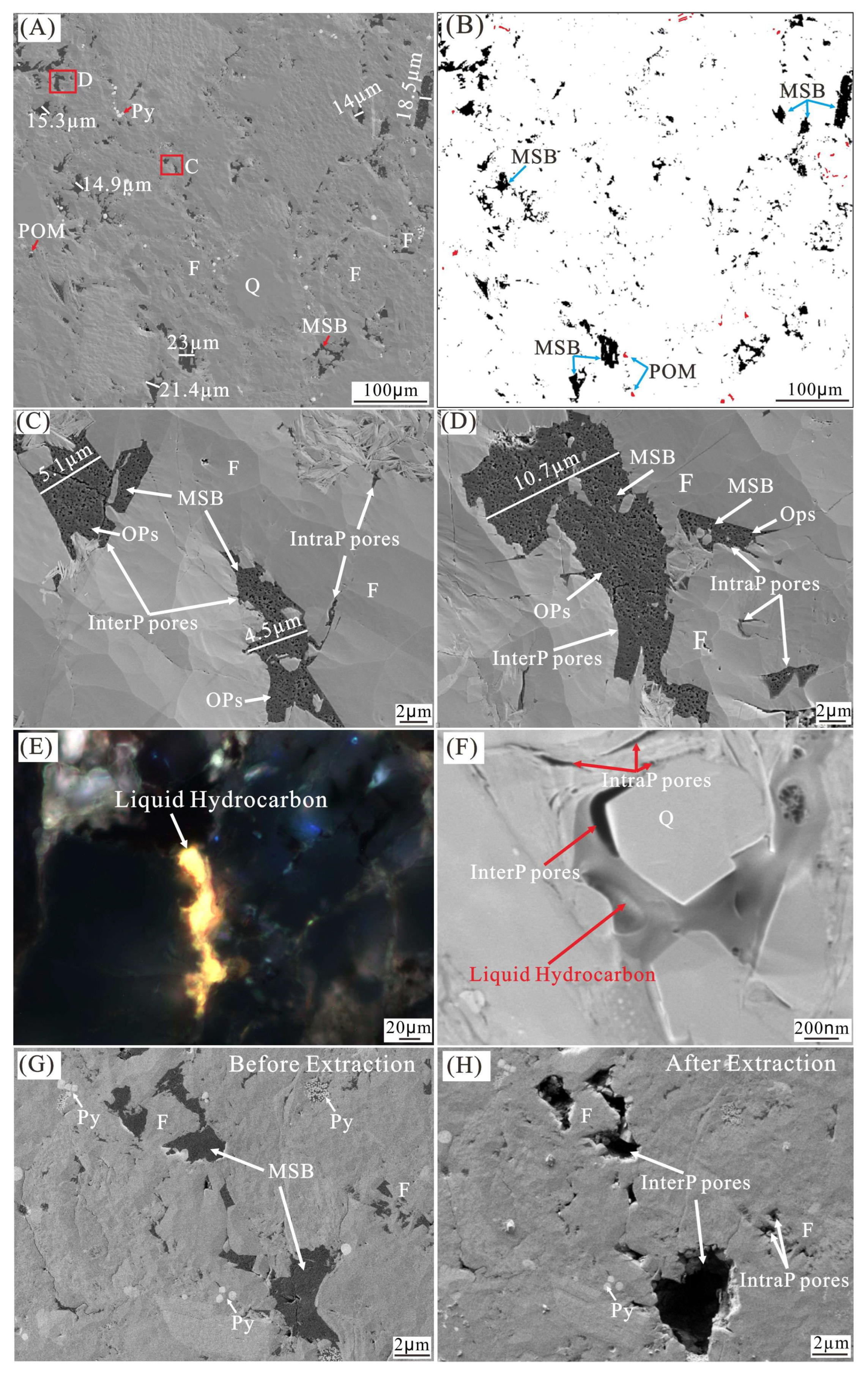



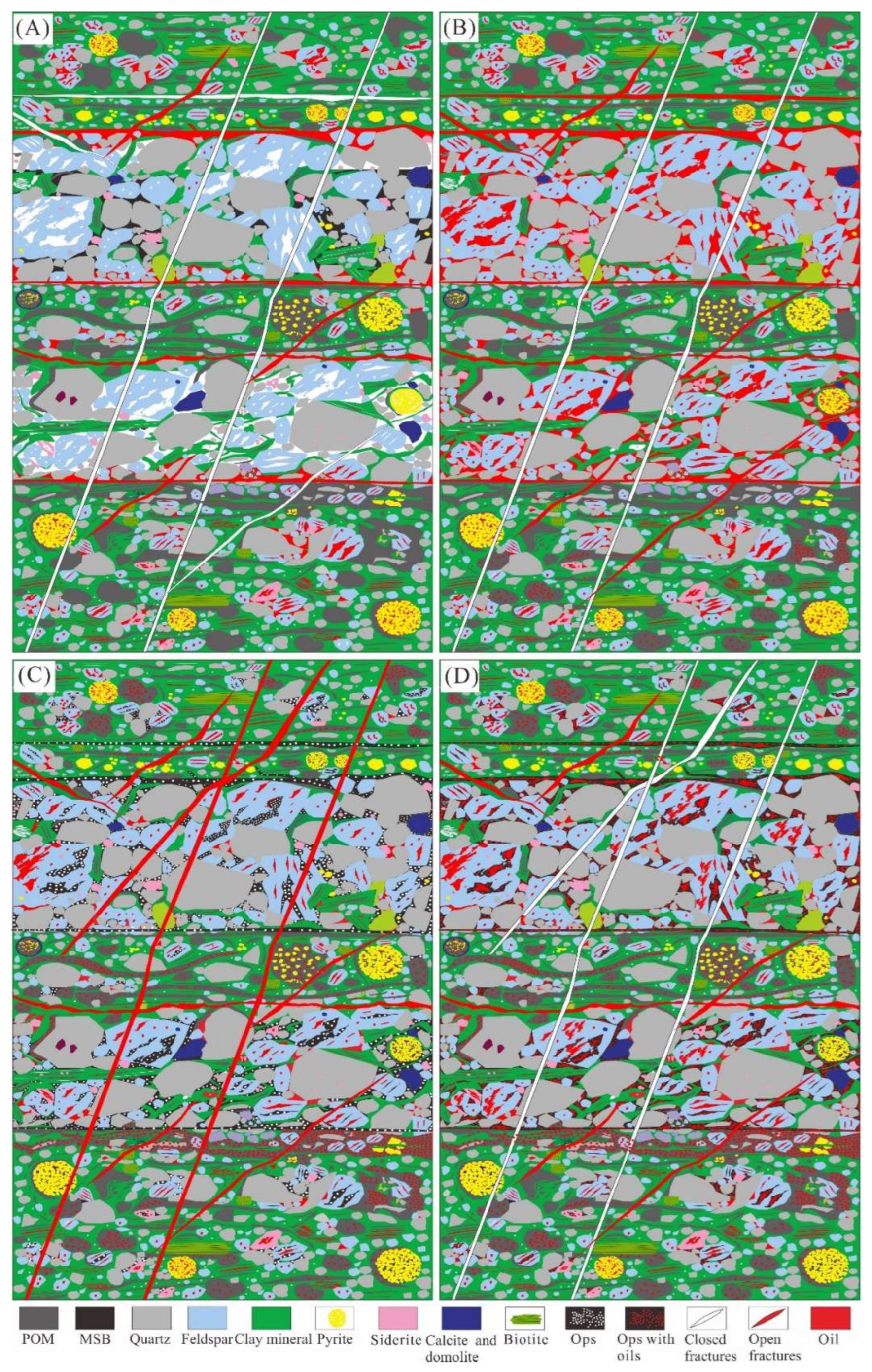
| Parameters | Sand-Silt Intervals | Mudstones with Interlayers | Mudstones | ||||||
|---|---|---|---|---|---|---|---|---|---|
| Min | Max | Average | Min | Max | Average | Min | Max | Average | |
| Quartz/% | 13.7 | 67.4 | 32.9 | 9.6 | 44.3 | 27.0 | 7.3 | 45.0 | 22.4 |
| Feldspar/% | 9.0 | 51.0 | 31.4 | 8.0 | 45.3 | 26.8 | 7.0 | 43.9 | 20.5 |
| Clay mineral/% | 10.9 | 55.8 | 26.5 | 11.9 | 71.0 | 39.1 | 13.9 | 74.4 | 48.3 |
| TOC/% | 0.39 | 7.36 | 2.32 | 0.45 | 8.58 | 4.36 | 1.37 | 20.27 | 5.86 |
| S1/mg/g | 0.17 | 6.86 | 2.29 | 0.34 | 8.36 | 4.0 | 1.24 | 13.09 | 4.37 |
| S2/mg/g | 0.25 | 15.22 | 4.44 | 0.31 | 15.71 | 9.21 | 0.39 | 48.29 | 11.52 |
| EOM/% | 0.08 | 1.73 | 0.60 | 0.33 | 1.43 | 0.92 | 0.16 | 2.73 | 0.89 |
| HI/mg/g TOC | 64 | 474 | 181 | 54 | 333 | 190 | 51 | 839 | 197 |
| OSI/mg/g TOC | 21 | 212 | 105 | 33 | 185 | 101 | 10 | 247 | 82 |
| Porosity/% | 0.55 | 8.37 | 4.28 | 0.54 | 7.70 | 3.89 | 0.54 | 7.34 | 3.39 |
Disclaimer/Publisher’s Note: The statements, opinions and data contained in all publications are solely those of the individual author(s) and contributor(s) and not of MDPI and/or the editor(s). MDPI and/or the editor(s) disclaim responsibility for any injury to people or property resulting from any ideas, methods, instructions or products referred to in the content. |
© 2025 by the authors. Licensee MDPI, Basel, Switzerland. This article is an open access article distributed under the terms and conditions of the Creative Commons Attribution (CC BY) license (https://creativecommons.org/licenses/by/4.0/).
Share and Cite
Lei, Y.; Zhang, L.; Wang, X.; Liu, N.; Cheng, M.; Cai, Z.; Yin, J. Heterogeneity of the Triassic Lacustrine Yanchang Shale in the Ordos Basin, China, and Its Implications for Hydrocarbon Primary Migration. Appl. Sci. 2025, 15, 7392. https://doi.org/10.3390/app15137392
Lei Y, Zhang L, Wang X, Liu N, Cheng M, Cai Z, Yin J. Heterogeneity of the Triassic Lacustrine Yanchang Shale in the Ordos Basin, China, and Its Implications for Hydrocarbon Primary Migration. Applied Sciences. 2025; 15(13):7392. https://doi.org/10.3390/app15137392
Chicago/Turabian StyleLei, Yuhong, Likuan Zhang, Xiangzeng Wang, Naigui Liu, Ming Cheng, Zhenjia Cai, and Jintao Yin. 2025. "Heterogeneity of the Triassic Lacustrine Yanchang Shale in the Ordos Basin, China, and Its Implications for Hydrocarbon Primary Migration" Applied Sciences 15, no. 13: 7392. https://doi.org/10.3390/app15137392
APA StyleLei, Y., Zhang, L., Wang, X., Liu, N., Cheng, M., Cai, Z., & Yin, J. (2025). Heterogeneity of the Triassic Lacustrine Yanchang Shale in the Ordos Basin, China, and Its Implications for Hydrocarbon Primary Migration. Applied Sciences, 15(13), 7392. https://doi.org/10.3390/app15137392






